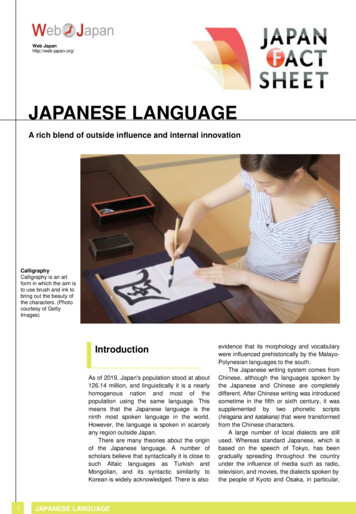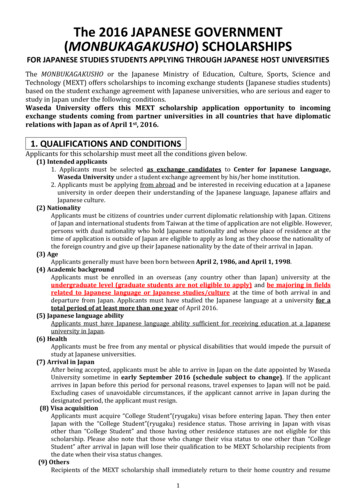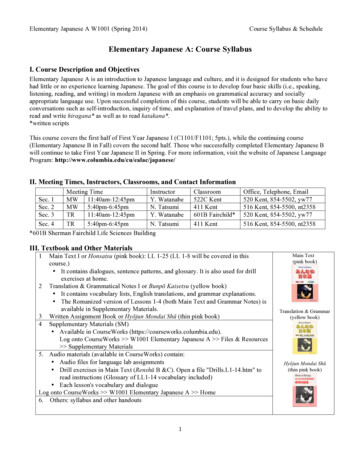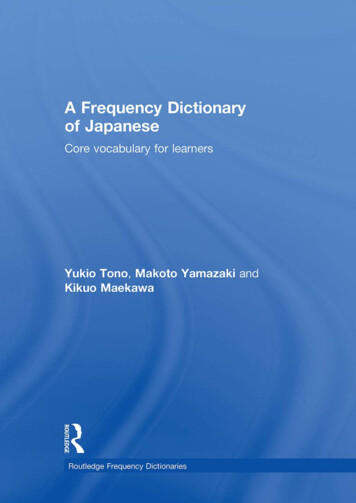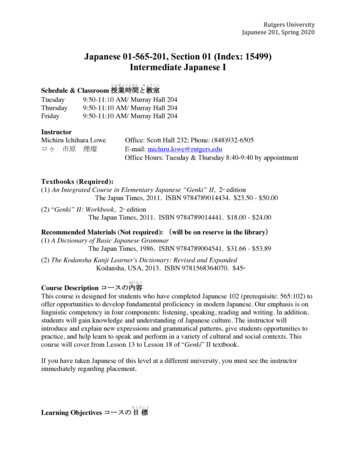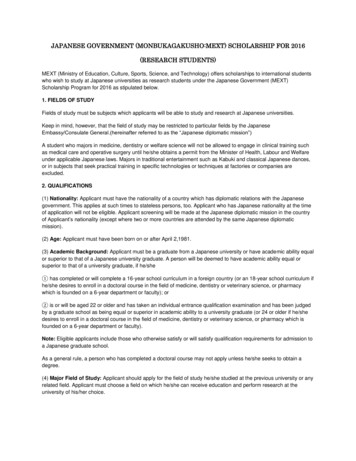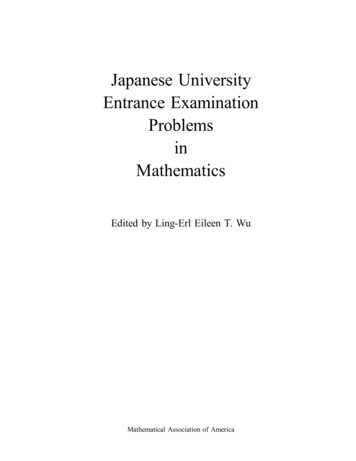
Transcription
Japanese UniversityEntrance ExaminationProblemsinMathematicsEdited by Ling-Erl Eileen T. WuMathematical Association of America
Table of ContentsIntroduction . . . . . . . . . . . . . . . . . . . . . . . . . . . . . . . . . . . . . . . . . . . . . . . . . . . . . . . . . . . . . . . . . . . . . . . . . . . . . . . . . . . . . . . . . . . . . . . . . . . . . . . 31990 University Entrance Center Examination (UECE) . . . . . . . . . . . . . . . . . . . . . . . . . . . . . . . . . . . . . . . . . . . . . . . . . . . . . . . . . . . . . . . 4Results of Performance on 1990 UECE . . . . . . . . . . . . . . . . . . . . . . . . . . . . . . . . . . . . . . . . . . . . . . . . . . . . . . . . . . . . . . . . . . . . . . . . . . . . . .7Evaluation of 1990 University Entrance Center Examination (UECE)I. Opinions of and Evaluations by Senior High School Teachers1. Preface . . . . . . . . . . . . . . . . . . . . . . . . . . . . . . . . . . . . . . . . . . . . . . . . . . . . . . . . . . . . . . . . . . . . . . . . . . . . . . . . . . . . . . . . . . . . . . . . . . . . 72. Content and Scope of the Exam Problems . . . . . . . . . . . . . . . . . . . . . . . . . . . . . . . . . . . . . . . . . . . . . . . . . . . . . . . . . . . . . . . . . . . . .83. Analysis of the Exam Problems . . . . . . . . . . . . . . . . . . . . . . . . . . . . . . . . . . . . . . . . . . . . . . . . . . . . . . . . . . . . . . . . . . . . . . . . . . . . . . 94. Summary . . . . . . . . . . . . . . . . . . . . . . . . . . . . . . . . . . . . . . . . . . . . . . . . . . . . . . . . . . . . . . . . . . . . . . . . . . . . . . . . . . . . . . . . . . . . . . . . . 10II. Analysis by Division of Research, Senior High School Division, Association of Japanese Mathematical Education1. Guidelines for Exam Problems . . . . . . . . . . . . . . . . . . . . . . . . . . . . . . . . . . . . . . . . . . . . . . . . . . . . . . . . . . . . . . . . . . . . . . . . . . . . . . 112. On This Year’s Problems . . . . . . . . . . . . . . . . . . . . . . . . . . . . . . . . . . . . . . . . . . . . . . . . . . . . . . . . . . . . . . . . . . . . . . . . . . . . . . . . . . . 113. Students’ Group Divisions and Performances . . . . . . . . . . . . . . . . . . . . . . . . . . . . . . . . . . . . . . . . . . . . . . . . . . . . . . . . . . . . . . . . . 114. Content and Intent of Math I, Math II Problems, and Exam Results . . . . . . . . . . . . . . . . . . . . . . . . . . . . . . . . . . . . . . . . . . . . 115. Analysis of Criticism and Opinions on Exam Problems . . . . . . . . . . . . . . . . . . . . . . . . . . . . . . . . . . . . . . . . . . . . . . . . . . . . . . . 126. The Make-Up Exam . . . . . . . . . . . . . . . . . . . . . . . . . . . . . . . . . . . . . . . . . . . . . . . . . . . . . . . . . . . . . . . . . . . . . . . . . . . . . . . . . . . . . . . 137. Points to be Considered in Constructing Problems in the Future . . . . . . . . . . . . . . . . . . . . . . . . . . . . . . . . . . . . . . . . . . . . . . . .13Survey of UECE . . . . . . . . . . . . . . . . . . . . . . . . . . . . . . . . . . . . . . . . . . . . . . . . . . . . . . . . . . . . . . . . . . . . . . . . . . . . . . . . . . . . . . . . . . . . . . . . . 13Results of Survey on University Entrance Center Examination . . . . . . . . . . . . . . . . . . . . . . . . . . . . . . . . . . . . . . . . . . . . . . . . . . . . . . . . 14Conclusion . . . . . . . . . . . . . . . . . . . . . . . . . . . . . . . . . . . . . . . . . . . . . . . . . . . . . . . . . . . . . . . . . . . . . . . . . . . . . . . . . . . . . . . . . . . . . . . . . . . . . . 15References . . . . . . . . . . . . . . . . . . . . . . . . . . . . . . . . . . . . . . . . . . . . . . . . . . . . . . . . . . . . . . . . . . . . . . . . . . . . . . . . . . . . . . . . . . . . . . . . . . . . . . . 15Appendix I: Individual University Examinations . . . . . . . . . . . . . . . . . . . . . . . . . . . . . . . . . . . . . . . . . . . . . . . . . . . . . . . . . . . . . . . . . . . . . 15Appendix II: Solutions to University Examinations . . . . . . . . . . . . . . . . . . . . . . . . . . . . . . . . . . . . . . . . . . . . . . . . . . . . . . . . . . . . . . . . . . 19Published and distributed byThe Mathematical Association of AmericaThis project was supported by the Alfred P. Sloan Foundation. Any opinions, findings, conclusions, or recommendations expressed herein donot necessarily reflect the views of the Alfred P. Sloan Foundation.c 1993by The Mathematical Association of America (Incorporated)2
JAPANESE EXAMIntroductionIn Japan, higher education is considered to be one of the most important factors in obtaining a good job. Consequently, one’s socialstatus depends greatly on the level and quality of one’s education.Since Japan is a fairly affluent nation, most families can afford highereducation for their children. However, with a limited number of prestigious universities, competition on the entrance exam is very keen.Although the overall acceptance rate at four-year institutions in recentyears has been above 60%, the acceptance rate at national and localpublic universities has been only 26%. As a result even at the elementary school level some Tokyo students attend additional eveningor Saturday classes to prepare for the entrance examination for thebest private junior high schools (grades 7, 8, 9) and high schools(grades 10, 11, 12) in order to be well prepared for the universityentrance examination.The purpose of this report is to give samples of Japanese entranceexaminations in the field of mathematics along with the performanceresults of the 1990 examination. It is hoped that a better understanding of the level of mathematics expected of Japanese students willgive mathematics educators in the U. S. a basis for comparison whenreviewing the U. S. secondary school mathematics curriculum andexpectation of student performance.The editor deeply appreciates the generous assistance of ProfessorHiroshi Fujita of Meiji University, Tokyo, Japan in obtaining the data.Professor Fujita is a member of the committee currently reviewingthe Japanese national curriculum and is in charge of the Senior HighSchool Mathematics Division of the Council for Educational Curriculum. He has presented papers on Mathematics Education of theSenior Secondary Level in Japan at the National Council of Teachersof Mathematics (NCTM) meetings in the U.S., at the InternationalCongress on Mathematical Education (ICME) in Budapest, and atother international conferences. The editor also would like to expressspecial thanks to Professor Richard Askey, University of Wisconsin,for his thorough and helpful reading of the manuscript and for hisvaluable comments and suggestions. The editor sincerely thanks theAlfred P. Sloan Foundation for the financial support which madethis project possible. Also special appreciation is due Beverly Ruediat the MAA for her efficient and excellent work. To the publisher,Obunsha, the author gratefully acknowledges their assistance and cooperation in granting permission to translate material from the ”1991Zenkoku Daigaku Nyuushi Mondai Seikai Suugaku (Kokkouritsudaihen)” [1991 University Entrance Examinations in Mathematics:Problems & Solutions—Edition for National & Local Public Universities]. The editor attempted to give an accurate and readabletranslation, she accepts full responsibility for any errors that mayappear here.The entrance examination for a national or local public universityin Japan consists of two parts:1. Standardized Primary Exam—UECEThe University Entrance Center Examination (UECE) is administered by a government agency, the Center for University Entrance Examinations. This examination is based on the high school curriculumset forth by the Ministry of Education. Prior to 1990, this examination was called the Joint First Stage Achievement Test (JFSAT). Allapplicants for national or local public universities are required to takethis examination. It is offered once a year, usually in mid-January,with the make-up examination scheduled one week later.32. Secondary ExamThis additional exam is given independently by each university ata later date. Generally the examination dates for national and localpublic universities are divided into two types:(i) Two-stage type—two exam dates, usually two weeks apart, withpre-determined allocation of entrants, about a 9 to 1 ratio.(ii) AB-date (or ABC-date) type—two (or three) exam dates, A-dateand B-date, (and C-date), usually one week apart, uniformly seteach year.A-date coincides with First-stage date in (i).Thus there are four possible paths offering a student two chances totake an entrance exam for a public university:(a)(b)(c)(d)A-date exam B-date examA-date exam Second-stage examFirst-stage exam B-date examFirst-stage exam Second-stage exam.If a student passes the First-stage exam of a university and decidesto enter the university, the student is required to proceed with registration shortly after the exam result is known. Then the student losesapplicant status for the Second-stage exam or accepted status for theB-date exam, whichever status the student held.Each university sets the relative weights of the two examinationscores in its admissions decisions. The ratio of UECE score weightsto the individual university examination weights is typically about40% to 60%, or 50% to 50%. Tokyo University is an extreme case,setting the ratio of weights at 20% for the UECE score to 80% forthe Tokyo University score.In 1990, about 6% of those admitted to the four-year nationalor local public universities gained admission by recommendations;some took only the UECE and some were exempt from both theUECE and the individual university examination. Although the recentimprovement in secondary examination scheduling enables a studentto take two national or local public university exams, most applicantstarget an exam given on the first date or A-date because an examgiven on the second date tends to be more difficult and has a smallerallocation of admittees.According to the Ministry of Education, about 73% of universitystudents were enrolled in private universities in 1987. In the past,JFSAT was primarily for the national and local public universitiesand only the individual university examination was required for private universities. When UECE replaced JFSAT in 1990, one of theobjectives of the UECE Committee was to make the examinationeasier for private as well as public universities to utilize. Sixteenof the 342 private universities joined all 132 national and local public universities to participate in 1990. Twenty-one private universitiesparticipated in UECE in 1991 and 31 participated in 1992. Currently,most private university applicants do not take the UECE.Private universities admit a somewhat larger percentage of theirstudents by recommendations. In 1984 the rate was about 20%. In1991 at Asia University in Tokyo, 40 of the 400 admitted by recommendations were exempt from taking the UECE and the university’sentrance examination. Unlike national and local public universities,private universities’ entrance examination dates are not uniform, allowing applicants to take many private university examinations. Inrecent years students have applied to an average of 6 private universities.
4Japanese University Entrance Examination Problems in MathematicsEven though the use of UECE in Japan is not yet as widespread asthat of the SAT in the U.S., it plays a similar role. See the followingtable for comparison data.1987Japan U. S. Population age 181,883,0003,667,000High school roportion of HS grads38%57%Proportion of the age group36%41%Number of students who took:UECE (formerly JFSAT)SAT256,000(1)Proportion of the age groupHigh school graduatesenrolled in college1,134,000Proportion of HS gradsenrolled in college38%75%Proportion of HS grads14%43%Proportion of the age group14%31%Applicants to universitiesor junior collegesAccepted applicantsAcceptance rateDirections: Each problem contains several blanks. Blanks are represented by bracketed, underlined numbers. Each blank must be filledwith a single digit or sign. See the method shown in the followingexamples and answer in the specified space on the answer sheet:1. {1}, {2}, {3}, {4}, . . . each represent values between 0 and 9 or or signs. For example, to indicate 8 as the answer to {1}{2},mark 0 1 2 3 4 5 6 7 8 9{1} 8 9{2} 0 1 2 3 4 5 6 7 2. If the answer is a fraction, reduce the fraction to its lowest termsand indicate the sign in the numerator. For example, to indicate 2/9as the answer to {3}{4}/{5}, mark 0 1 2 3 4 5 6 7 8 9{3} 2 3 4 5 6 7 8 9{4} 0 1 9{5} 0 1 2 3 4 5 6 7 8 Mathematics A [Mathematics I](100 points, 60 minutes)1,025,000681,0001990 UECE in Mathematics2,246,000(2)66%Section 1 (30 points)1. Suppose the polynomial P (x) with integer coefficients satisfiesthe following conditions:The 1990 UECE in mathematics is divided into two sections: Section A consists of Mathematics I and Section B consists of eitherMathematics II, Industrial Mathematics, or Accounting/Statistics I,II. Depending on the student’s area of study, he or she will selectthe appropriate examination in Section B. Of the 327,543 applicantswho took Section B in 1990, 327,034 took the Mathematics II, 52took Industrial Mathematics, and 457 took Accounting/Statistics I,II. Because of the significantly greater number of applicants takingMathematics I and II, only those two examinations will be consideredin the following article.Ling-Erl Eileen T. WuMenlo College(A) If P (x) is divided by x2 4x 3, the remainder is 65x 68.(B) If P (x) is divided by x2 6x 7, the remainder is 5x a.Then we know that a {1}.Let us find the remainder bx c when P (x) is divided by x2 4x 21.Condition (A) implies that {2} b c {3}{4}{5} and a {1}.Condition (B) implies that {6}{7} b c {8}{9}. It follows thatb {10} and c {11}{12}{13}.2. Fill in the blanks in statements (A) through (D) with the appropriate phrase [1], [2], [3] or [4] listed below:(A) Given sets A, B, A B A is {14} for A B B.(B) For some integer n, n2 being some multiple of 12 is {15} forn being a multiple of 12.(C) The center of the circle inscribed in triangle T coinciding withthe center of the circle which circumscribes triangle T is {16}for triangle T to be an equilateral triangle.Data from Monbusho: Outline of Education in Japan, 1989.Data from the 1989–90 Fact Book on Higher Education by AmericanCouncil on Education and Macmillan Co. and the Digest of Education Statistics (Government Printing Office, Washington, DC, 1991).(1) The figure excludes approximately 138,000 of those who graduated priorto 1987.(2) First time freshman including H.S. graduates of other years. (D) Given real numbers a, b, and c, a b c a b c is {17} for ab bc ca 0.[1] a necessary and sufficient condition[2] a necessary but not sufficient condition
Answers to Mathematics A [Mathematics I]5[3] a sufficient but not necessary condition[4] neither a sufficient nor a necessary conditionAnswers to Mathematics A [Mathematics I](100 points)Section 2 (35 points)Section 1Let a be a constant. Consider the parabola1.Ca : y x2 ax a2 .1. Since the coordinates of the vertex of Ca area {2} 2,a ,{1} {3}2the vertex is on the curve y {4}x .2. Let be the line joining two points A ( 1, 1) and B (2, 4). Forthe parabola Ca and the line to have a common point, the value ofa must be{7}ora a {5}{6}.{8}The coordinates of the common point of parabola Ca and the line areand({9}{10}, {11}) ,when a {5}{6}2.1.{16} a {18}.{17}2.Consider the triangle ABC with coordinates A (0, 3), B ( 1, 0)and C (2, 1).{6}{7}b c {8}{9} 7b c 37b {10}b 9c {11}{12}{13}c 100{14}1{15}2{16}1{17}3a {2} 2,a{1} {3}a 5 2, a2 45x2a {5}{6}a 1a {7}/{8}a 7/5({9}{10}, {11})( 1, 1)1 11,5 5{16}/{17} a {18}7/5 a 2,Section 3{5} {6}.{7}sin ABC 3b c 127{12} {14},{13} {15}1. The center of the circumscribed circle isAlso,{2}b c {3}{4}{5}{4}x2Section 3 (35 points)and the radius isa 2Section 2{12} {14}{7},.,when a {13} {15}{8}Also, in order for the parabola Ca and the line segment AB to havetwo distinct points of intersection,{1} {3},{2} {4}a {1}1.1 5,4 4 5 24{5} {6}{7}{8},{9}and the area of triangle ABC is {10}.From these conditions, we know that the radius of the inscribedcircle is{11}{12} {13}.{14}2. If point P moves along the sides of triangle ABC, the maximumvalue of the distance between the origin O and point P is {15} andthe minimum value is1.{16}{17}{1} {3},{2} {4}{8}{9}45{10}4 10 22{11}{12} {14}2.{15}1{16}{17}{13}31 10
6Japanese University Entrance Examination Problems in MathematicsMathematics B [Mathematics II](100 points, 60 minutes)(1) a {1}, b {2}{3} and the local maximum value of thefunction f (x) isChoose two of the following three sections:Section 1 (50 points)1. In a circle with radius 2 and its center at the origin O, let thevertices of an inscribed hexagon be ABCDEF , with the coordinatesof A at (2, 0), and with B in the first quadrant.(1) The components of the vector AB 2DE 3F Aare {1}{2}, {3}{4} {5} .(2) If t is a real number, the magnitude of the vector{4} {5}.{6}(2) The value of the slope m of the tangent line at point P on thecurve y f (x) is greater than or equal to {7}{8}. If m tan θ(0 θ 180 ), then the range of values for θ is 0 θ {9}{10} or {11}{12}{13} θ 180 .(3) The volume of the solid generated by revolving the regionbounded by the x-axis and the curve y f (x) about the xaxis is{14}{15}π.{16}{17}{18}2. 1, 1/2, 1/2, 1/4, 1/4, 1/4, 1/4, . . . is a sequence where 1/2k 1appears 2k times successively (k 1, 2, 3, . . .). AB tEF(1) Then the sum of the first 1000 terms isis a minimum when the value of t is{19} {6}{7}and the minimum magnitude is(2) If the sum of the first n terms is 100, then because{8}.n 2{24}{25}{26} {27},2. Let ABCD be a quadrilateral with BC 2ADn is a {28}{29} digit number provided that log10 2 0.3010.Section 3 (50 points)AB CD DA 2 AD a BA bThe numbers 1 through 9 are written individually on nine cards.Choose three cards from the nine, letting x, y, and z denote thenumbers of the cards arranged in increasing order.(1) Let M be the midpoint of CD. Since BCM {9}{10} ;BM Also{11}{12}.1. There are {1}{2} such x, y, and z combinations.2. The probability of having x, y, and z all even is {13} {15} b.(1)a BM {14}{16}(2) Let P be a point on AB, and let Q be the point of intersectionof P C and BM . Suppose P Q : QC 1 : 2. Let us findAP : P B and BQ : QM . If we set{3}.{4}{5}3. The probability of having x, y, and z be consecutive numbers is{6}.{7}{8} BP tBA,we have {17} BQ ( a t b ).{18}Therefore, from (1) and (2),t {20}{21}{22}.2{23}(2){19}.{20}It follows that AP : P B {21} : {22}, BQ : QM {23} :{24} and{25}{27}{28}.BQ {26}Section 2 (50 points)1. The functionf (x) x 3 ax2 bx has the local minimum value (2 3)/9 at x 1/ 3. Then,4. The probability of having x 4 is{9}.{10}{11}5. Possible values of x range from {12} to {13}. If k is an integersuch that {12} k {13}, the probability of x k is({14} k)({15} k).{16}{17}{18}The expected value of x is{19}.{20}
EVALUATION OF THE 1990 UECE7Answers to Mathematics B[Mathematics II] (100 points)Section 11.({1}{2}, {3}{4}{5}){6}/{7}{8}2.{9}{10}{11}{12}3. ( 4, 4 3)1/2 3 3 1 a b22{17}/{18}2/3{19}/{20}1/3{21} : {22}2:1{23} : {24}4:5{25}{26}4 1395.{12}, {13}1, 7({14} k)({15} k){16}{17}{18}{19}{20}(9 k)(8 k)(8 k)(9 k)or16816852Results of Performanceon 1990 UECEEXAMINATIONNumber ofStandardParticipants Average High Low DeviationMATHEMATICS AMathematics IMathematics II{1}0Industrial Math.{2}{3} 1 2 39Accounting/Stat. I, S BSection 21.{9}{10}{11}60 13 {15} {13} a b{14}{16}{27}{28}4.{7}{8} {19}9{20}{21}{22}2{23}48929n 2{24}{25}{26} {27}n 2100 1{28}{29}31Section 31.{1}{2}842.{3}{4}{5}1213.{6}{7}{8}112Evaluation of the 1990 UniversityEntrance Center Examination(Direct translation of the text)I. Opinions of and Evaluations bySenior High School Teachers1. PrefaceDiscussions and research into establishing a more suitable university entrance examination to accommodate a great increase in thenumber and diversity of university applicants have allowed privateuniversities to participate along with the national universities.Accordingly, we revised the contents of the examinations. Originally, Math I and Math II combined were 100 minutes, 200 points;the UECE in mathematics is currently divided into two groups: MathA [Math I] and Math B [Math II], each exam being 60 minutes longand worth 100 points.
8The purpose of the UECE is, as before, to assess the degree ofmastery of the general fundamental learning established for the seniorhigh schools. Considering the various ways the UECE is utilized inselecting university entrants, fairness to the exam participants wasemphasized by posing the following questions:(1) whether exam problems (content, questions, score distributions,format, etc.) accurately assess the level of fundamental learning;(2) whether there is a wide difference in the degree of difficultybetween the main exam and the make-up exam;(3) whether there is a great difference in the degree of difficultyamong optional problem sections.With these criteria in mind, we will analyze the 1990 exam problemsfrom the following points of view:(1) whether the exam problems fulfill the purpose of the UECEexam;(2) whether Math I, Math II are consistent with the guidelines setforth by the senior high schools;Japanese University Entrance Examination Problems in MathematicsSection 3. Two-dimensional graphs and related expressions, trigonometric ratios1. Find the center and the radius of the circle passing through threepoints A, B, and C in a plane. Also, find sin ABC and the areaof 4ABC using either the law of sines or the law of cosines. Thenfind the radius of the inscribed circle.2. Find the maximum and minimum distances between the originand a point on a side of 4ABC.Mathematics IISection 1. Vectors1.Coordinatized two-dimensional vectors(1) Determine the coordinates of the given points and then find thecomponents of the vector.(2) Find the minimum value of the magnitude of the vector.(3) whether the content of exam problems tends to be esoteric;(4) whether the degree of difficulty of optional problem sections forMath II is uniform in the three sections;2. Two-dimensional vectors(5) whether the problems provide sufficient information to evaluatethe student’s mathematical thinking ability and ability to performcalculations;(1) Using the conditions given for the vectors, draw the graph andfind the angle. Using the law of cosines, find the length of a side.Also, express the vector in terms of two linearly independent vectors a and b .(6) whether, for each problem, the level of difficulty, the method ofquestioning, the distribution of points, format, and so forth areappropriate;Section 2. Progressions, derivatives, integrals, and trigonometricfunctions(7) whether the problems reflect an improvement resulting from reviewing the past JFSAT and the Trial Center Exam administeredin 1988.2. Content and Scope of theExam ProblemsMathematics ISection 1. Numbers and expressions, equations and inequalities1. Polynomials with integer coefficients and equationsUsing the two conditions given and the remainder theorem, dividethe integral expression by the second-degree expression.2. Proofs and statementsCovering combinations, integers, graphs and inequalities from MathI, determine whether the condition given in each part is necessary,sufficient, or both.Section 2. Functions, two-dimensional graphs and expressions1. Find the coordinates of the vertex of a parabola and the equationof its locus.2. Find the condition for having common points between the linejoining the given two points and the parabola, and find the coordinates of the common points. Also, find the condition that the linesegment AB and the parabola have two distinct common points.1. Derivatives, integrals, and trigonometric functions(1) Determine the coefficients from the information given about theminimum value of the function. Also determine the maximumvalue of the function.(2) Make use of the derivative to find the minimum value for theslope. Find the range of the angle formed by the tangent and thepositive x-axis.(3) Find the volume of the solid generated by revolving the regionbounded by the curve and the x-axis about the x-axis.2. Progressions and logarithms(1) Consider the pattern of the progression, and make use of the sumformula for the geometric progression. This problem is beyondthe curriculum guidelines established for the senior high schoolsand requires special effort.(2) Given the sum, use the geometric progression to determine thenumber of terms n. Also, use the common logarithm to find thedigits of n.3. Probability(1) Determine the value of the combination.(2) Determine the probability of choosing three numbers from{2, 4, 6, 8}.(3) Determine the probability of choosing three consecutive numbers.(4) Determine the probability of choosing three numbers, of which4 is the smallest number.(5) If the smallest of three numbers is k, find the range for k. Alsofind the probability of k being the smallest number and then findthe expected value of the smallest number.
EVALUATION OF THE 1990 UECE93. Analysis of the Exam ProblemsSection 3Mathematics I1. In order to find the center of the circumscribed circle of 4ABC,solve a system of simultaneous equations by setting the equation ofthe circumscribed circle to beSection 11. This basic problem using the remainder theorem is typical fora university entrance exam. If one knows the remainder theorem, itis unthinkable that one should miss this problem, aside from errorsin calculations. This problem is suitable for testing the level of thebasic learning established for senior high schools.2. The format for this problem on expressions and proofs ismultiple-choice because it was assumed that more participantscould answer the problems intuitively.(1) In set theory, (A B) B and A (A B) are basic knowledge, but the senior high school textbooks do not cover this indetail. We think that many answered hastily without consideringthe proof.(2) If n is a multiple of 12, then n2 is a multiple of 12. This isobvious. To disprove the converse is not too difficult.(3) If T is an equilateral triangle, then the center of the inscribedcircle and that of the circumscribed circle coincide. This canbe proven with the knowledge gained from junior high schoolmathematics. We think many chose the answer [A] without considering the proof.(4) Perhaps it did not occur to the students to square both sides of a b c a b c and even if it had occurred to them, it would have appeared thatfinding a counterexample to the converse required too much timeand work. We feel that more students considered the problemintuitively.In these types of multiple-choice questions, it is difficult to see thelogical thinking process. We would like to see an improvement madein the problem format; one which emphasizes the thought processthat leads to the conclusion, rather than a format that encouragesguessing the answer to the problem. We assume that this type oftheorem-proof problem develops logical thinking.Section 21. This is a basic problem. We think that the short questions in thefirst part were easy and not confusing. The coordinates of the vertexcan be obtained from the standard second-degree form. The equationof the locus can be found easily by eliminating the parameter a.This problem expresses the parabola by Ca , a notation rarely usedin textbooks.2. Parts {1} through {15} are textbook-level basic questions whichare considered easy to solve. For the remaining parts, it is importantto keep in mind thatx2 (a 1)x a2 2 0 and 1 x 2in order to have two distinct real solutions. This is a good question totest graphing ability and mathematical thinking. We feel participantswere unfamiliar with this type of problem; they either thought thatthey did not have enough conditions or miscalculated somewhere.Overall, the number of questions and the distribution of points arewell-balanced. These are good standard questions.x2 y 2 ax by c 0,or solve for the intersecting point of two perpendicular bisectors ofthe sides. We suspect that there were students who did not follow theproper order in these questions and who used sin ABC in the nextpart to solve for the radius of the circumscribed circle. The radius ofthe inscribed circle can be obtained by the formulaS rs.Depending on the textbook, the exact specification of this formulavaries.2. The shortest distance between the origin O and the point P canbe found simply by using the formula for the distance between apoint and a line. Since the forms of the formula vary depending onthe textbook, this problem requires some work. Overall, it is a goodquestion. There is no objection to its level, distribution of points, orformat.Mathematics IISection 11. (1) The positions of the vertices of the regular hexagon can beobtained by using the trigonometric ratios or symmetric points.We think it might have been better to ask the participants to findthe coordinates of point B or point F before asking (1).(2) Expressing the components of the vector AB tEF ,the minimum value of the magnitude of this vector can be foundfrom a second-degree function in t. Because there is another wayto solve the problem using the inner product, the problem shouldbe designed to ensure fairness to all participants.2. (1) BM can be obtained by the law of cosines or the Pythagoreantheorem. Consid
that of the SAT in the U.S., it plays a similar role. See the following table for comparison data. 1987 Japan U. S. Population age 18 1,883,000 3,667,000 High school graduates 1,792,000 2,647,000 Proportion of the age group 95% 72% High school graduates enrolled in college 681,000 1,503,000 Proportion of HS grads 38% 57%
